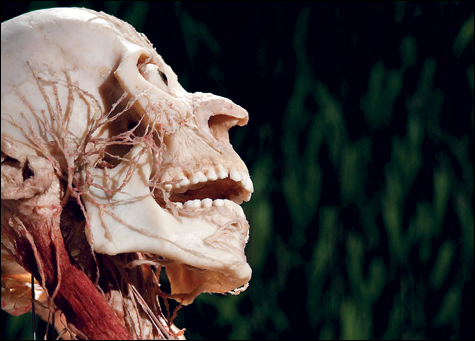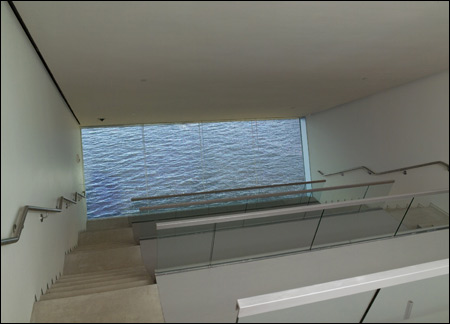
DUST TO DUST?: “Body Worlds 2” had them lining up at the Museum of Science. |
Preserved flayed corpses at the Museum of Science, Americans in Paris and Paris fashion collections at the Museum of Fine Arts, underground art at the Rhode Island School of Design Museum, beavers at Mass College of Art — it was that kind of year, capped off by the arrival of the new Institute of Contemporary Art. Here’s a look at what we got as seen by Greg Cook, Christopher Millis, Sharon Steel, David Eisen, and myself.1. NEW AND IMPROVED
After a three-month postponement, the new Diller Scofidio + Renfro–designed ICA finally opened, spreading its fourth-floor gallery space over Boston Harbor as if it were about to set sail. Will it revitalize Boston art? Will it revitalize the waterfront? And will it fit in with the new City Hall? Only time will tell.
2. WHERE’S OUR WUNDER?
Dazzling and inspiring at the RISD Museum, “Wunderground” offered a floor-to-ceiling survey of practically every poster produced to advertise under-the-radar Providence shenanigans from 1995 to 2005, plus Shangri-la-la-land, a “towering sculptural village” by nine artists that aimed to represent the best of the current scene. The Man smashed the old brick building in 2002 to erect a supermarket; still, Fort Thunder’s ghost lingers. You wonder how this scene got past the ICA.

3. THAT VISION THING
“Sensorium: Embodied Experience, Technology and Contemporary Art” at MIT’s List Visual Arts Center addressed the intersection of technology and physical sensation, with six international artists working in media ranging from sweat-scented walls to headgear that allowed you to see what others were seeing. At Brandeis’s Rose Art Museum, “Balance and Power: Performance and Surveillance in Video Art” looked at how the emergence of video art in the 1960s corresponded with the government’s use of surveillance equipment, photos, and videos as tools in thwarting anti-war and civil-rights protesters; yet it also showed artists filming unsuspecting subjects and employing surveillance footage as an element of artistic production.
4. DUST TO DUST?
In 1977, German scientist Dr. Gunther von Hagens invented a new way of preserving corpses for anatomical study that entailed replacing the body’s water tissue with fluid plastics. Result? “Body Worlds,” exhibitions of plastinated bodies, frequently in wacky poses, that have been donated by their one-time owners. “Body Worlds 2” came to the Museum of Science this summer, and the response necessitated extra evening viewing hours. Who can resist a good old-time freak show given the respectable imprimatur of science and edumacation? Especially one that raises the oldest question: what happens to us after we’re gone?

NEW AND IMPROVED: The Diller Scofidio + Renfro–designed ICA opened on the waterfront. |
5. A GOOD YEAR
The MFA didn’t serve up any blockbusters on the order of the Met’s “Fra Angelico” (see #7), but with shows that included “Facets of Cubism,” “Degas to Picasso: Modern Masters,” “David Hockney Portraits” (complete with a trenchant and edifying appearance by the artist), Laura McPhee’s “River of No Return,” “Americans in Paris 1860–1900,” “Domains of Wonder: Masterworks of Indian Painting,” and “Fashion Show: Paris Collections 2006,” it had nothing to apologize for.6. WIND FROM THE EAST
“Bellini and the East” at the Isabella Stewart Gardner Museum chronicled the journey made by Gentile (not his better-known brother Giovanni) Bellini to Istanbul in 1479, at the conclusion of a peace between Venice and the Ottoman Empire, in response to Sultan Mehmed II’s request for a Venetian painter. The MFA’s “Domains of Wonder: Masterworks of Indian Painting,” with more than 100 paintings from the 14th to the 19th century, reminded us that till, say, Hollywood films, there was little visual art as seductively romantic as Indian miniatures. And the breathtaking “Cosmophilia,” at Boston College’s McMullen Museum, assembled more than 100 works from the David Collection in Copenhagen to study decoration — figures, calligraphy, geometry, floral pattern — emerging from the Islamic cultures of Western Europe to East Asia from the seventh to the 19th century.
7. ANGEL ART
Modern art arose in the 15th century, at the dawn of Renaissance humanism, when artists began to paint what they saw rather than what they knew. Nothing could be less modern than Fra Angelico, whose “figures” are relationships rather than individuals. Even without that part — the major part — of his work that’s immovable, like the San Marco frescoes in Florence, the “Fra Angelico” show at the Met challenged you to think about visible and invisible in art.